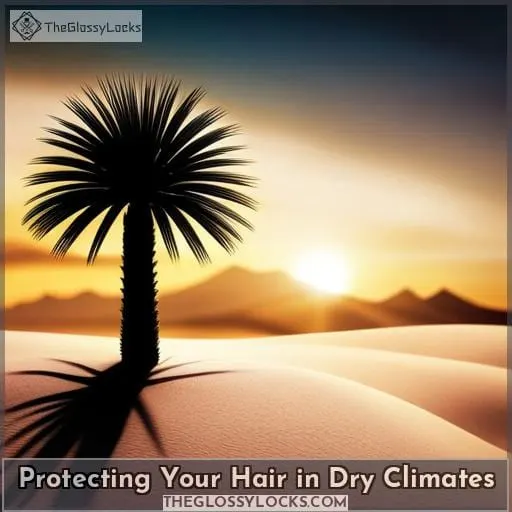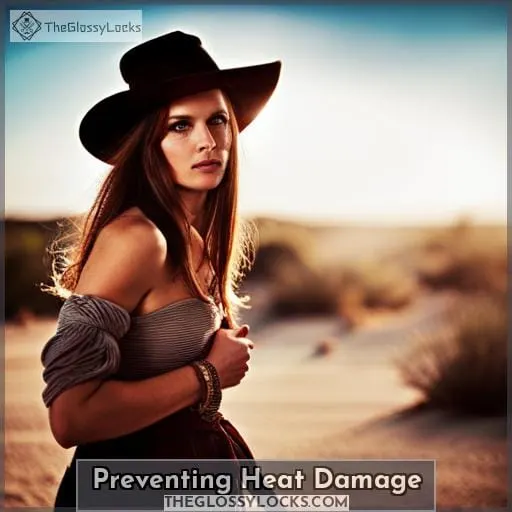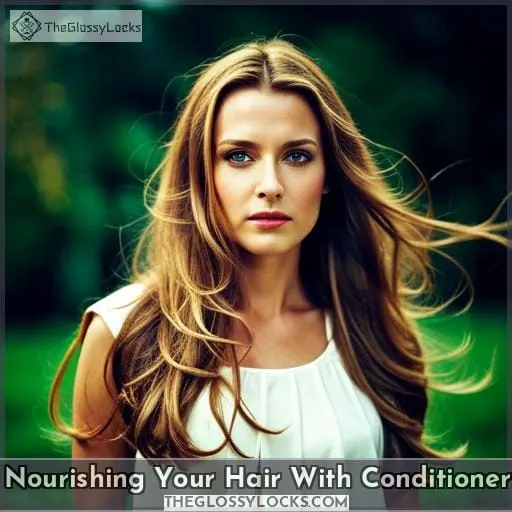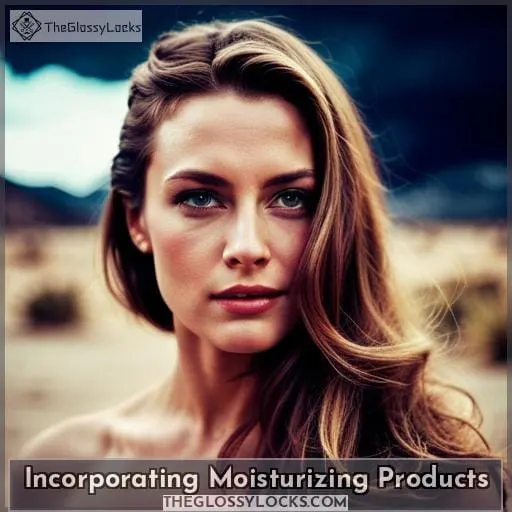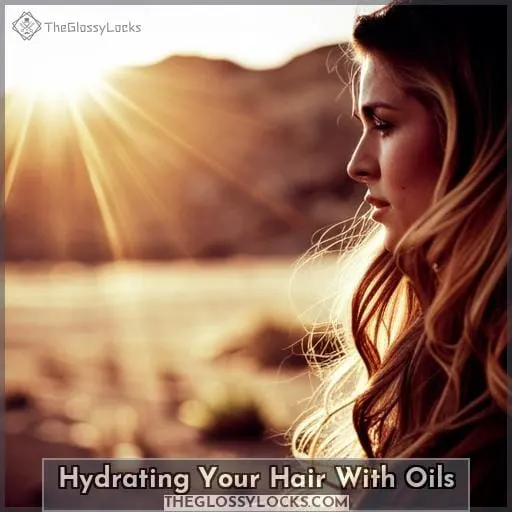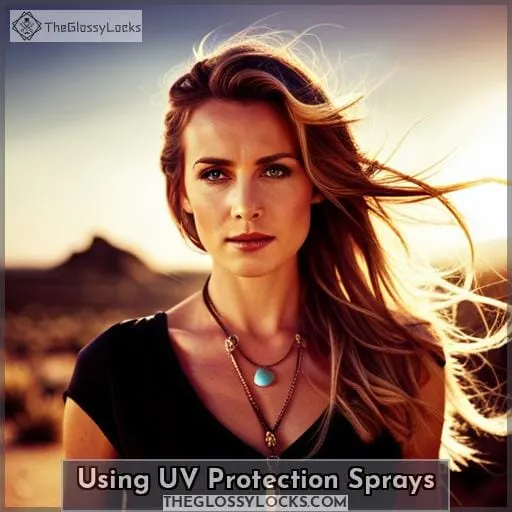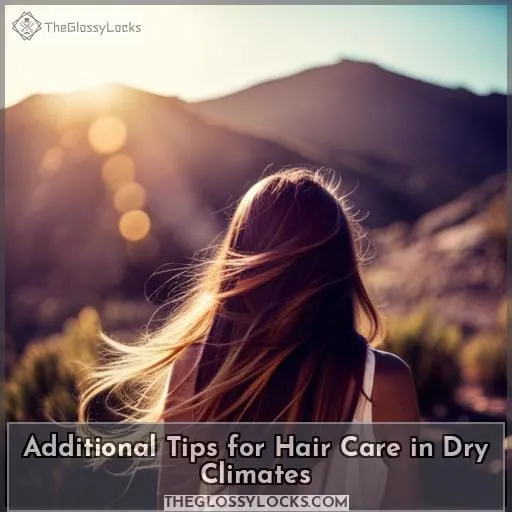This site is supported by our readers. We may earn a commission, at no cost to you, if you purchase through links.
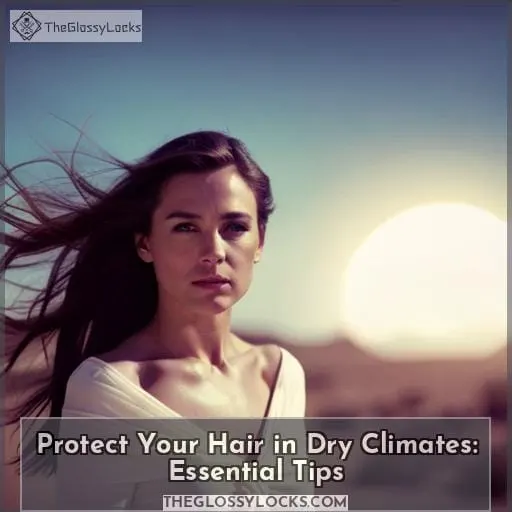 Do you live in an area with dry climates? You may have noticed that your hair is more prone to damage, breakage, and split ends. To keep your locks looking their best, it’s important to know how to protect hair in a dry climate.
Do you live in an area with dry climates? You may have noticed that your hair is more prone to damage, breakage, and split ends. To keep your locks looking their best, it’s important to know how to protect hair in a dry climate.
Here are some essential tips for maintaining healthy and hydrated locks no matter the weather conditions outside! From understanding the effects of a dry climate on your hair to incorporating moisturizing products and UV protection sprays into your routine – these steps will help ensure that you’re keeping up with proper care for damaged or fragile strands caused by arid air.
Table Of Contents
Key Takeaways
- Maintain proper hydration with humidifiers and drink enough water daily.
- Use heatless hairstyles and thermal protection products to avoid moisture loss from heat styling.
- Be cautious with glycerin-based products and opt for alcohol-free UV protectant sprays.
- Conditioner and masks are essential for hydration, and deep conditioning treatments help control frizz.
Protecting Your Hair in Dry Climates
Living in a dry climate can be challenging, especially when it comes to protecting and maintaining healthy hair. Understanding the effects of dry climates on your hair is key; humidity levels below 40% can lead to severe scalp dryness and frizzy locks.
Moisture is essential for preventing damage from occurring, so creating an effective moisture-based care routine should be a top priority.
Understanding the Effects of Dry Climate on Hair
Understanding how your city’s humidity level impacts your hair can help you take the protective measures needed in dry climates.
Heat styling strips moisture, so opt for heatless hairstyles like braids or ponytails whenever possible. Use thermal protection products when using tools to prevent further damage from heat. Products with glycerin draw moisture from the air, so use them cautiously in a dry climate.
Conditioner and masques keep locks hydrated, while oils lock in the moisture. But remember, water is key! Consider using humidifiers at night and drinking 8-12 cups of water daily.
Importance of Moisture in Dry Climates
It’s essential to keep your hair hydrated in dry climates, or else it’ll become brittle and dull. Look out for humidity levels through weather reports, and adjust scalp health accordingly.
Frizz control can be achieved by applying conditioner regularly to protect the hair from further damage due to low moisture levels.
Combining this with oils like argan oil can lock in moisture even more effectively, but remember not to overdo it! Stay informed on humidity changes through weather reports so that you know when extra conditioning is necessary.
Common Challenges Faced in Dry Climates
In dry climates, you may face common challenges such as frizzy hair and scalp dryness, but don’t fret! Use hydration techniques, like drinking 8-12 cups of water a day and using moisturizing products.
Understand how weather impacts your styling solutions by checking humidity reports. Opt for heatless hairstyles or use thermal protective products when using a blow-dryer. For extra protection from sun damage, look for alcohol-free UV sprays with glycerin content suitable for arid climates.
Moisture-seeking curls can benefit from sulfate-free shampoos and conditioners, plus regular deep conditioning treatments.
Preventing Heat Damage
If you live in a dry climate, it’s important to take steps to protect your hair from excessive heat styling tools. Consider using thermal protective products and opt for heatless hairstyles like ponytails or braids instead.
Minimizing Heat Styling Tools
To minimize heat damage, choose heatless styling tools and use thermal protection when necessary. Try ponytails or braids in dry climates to keep hair hydrated. Use chemical-free straightening treatments as an alternative to heated products.
Avoid blow dryers; if using one, set it 6 inches away at the cool setting and limit exposure.
Using Heat Protectant Products
Shield your tresses from heat styling with thermal protective products for the best results. Heat protection can keep hair healthy, allowing you to style safely while maintaining moisture balance. Consider using heatless hairstyles and sun protection when in dry climates to further protect hair from environmental factors.
UV sprays are better than traditional sunscreen, so look for alcohol-free and chemical-free options that still provide adequate coverage.
Choosing Heatless Hairstyles
When living in a dry climate, consider embracing heatless hairstyles like braids and ponytails to keep hair moisturized. Combat frizz by managing humidity levels with products tailored for natural textures.
Overnight care, such as using humidifiers, can help maintain moisture during extreme conditions. Curly girls can use accessories for adjustments too! Choose products that assist hydration and leave your locks looking luscious without the hassle of heat styling.
Nourishing Your Hair With Conditioner
Protecting your hair in dry climates is essential to maintain healthy, hydrated locks.
Regular Conditioning Routine
Nourish your strands with a regular conditioning routine to keep them hydrated and healthy in dry climates. Towel-dry before applying conditioner, deep condition weekly, use leave-in conditioners for extra moisture, shield from UV rays with protection sprays, and opt for water-based products instead of oils.
Natural oils can still be used but sparingly – combine them with humidifiers to maintain hair’s healthiness.
Deep Conditioning Treatments
Get ready to quench that thirsty mane of yours with a deep conditioner! This miracle treatment helps restore moisture balance, keeping your hair hydrated in dry climates. Whether it’s the sun or lack of external moisture, a deep conditioning can rescue brittle strands and give you back softness and shine.
Follow these tips for optimal results:
Conditioning Techniques:
- Use weekly masks/treatments
- Incorporate oils to lock in moisture
- Shampoo every other day + cold rinse finish
Dry Climate Tips:
- Minimize heat styling & chemical treatments
- Avoid blow-dryers & UV protection sprays
- Increase water intake
Deep conditioning is essential for long-lasting nourishment. Get creative with products featuring glycerin, which draws needed humidity from the air — plus no alcohol or chemicals! Keep up this routine for healthy hair even when living life on the dry side.
Towel Drying Technique
Before applying conditioner, gently towel dry your hair to maximize moisture absorption! This helps lock in hydration and prevent frizz while preserving its texture. Relative humidity levels also affect how quickly your hair dries, so use a blow-drying technique that works best for you in dry climates.
Towel drying is great for prepping the scalp and locking in moisture without stripping it of essential oils – just make sure not to rub too hard as this can damage fragile strands.
Minimizing Chemical Treatments
Navigating chemical treatments in dry climates can be tricky, but it’s essential to protect your hair from further damage. To avoid moisture loss, consider using heatless hairstyles and focus on natural straightening techniques instead of harsh chemicals.
Additionally, limit color treatments and minimize the use of blow dryers when possible for best results.
Impact of Chemical Treatments in Dry Climates
To keep your hair healthy in a dry climate, consider minimizing chemical treatments such as coloring and straightening. Can you reduce harsh chemicals without compromising style? Chemical-free alternatives like filtered water can help maintain moisture, while color treatment effects can weaken strands.
Professional advice is recommended to minimize chemicals when straightening in a dry climate.
Choosing Chemical-Free Alternatives
When looking to avoid chemical treatments in dry climates, consider natural alternatives that can still keep your hair healthy and hydrated. Try cleansing conditioners, clay washes, or jojoba oil for a gentle cleanse. For added moisture and shine, try SheaMoisture Raw Shea Butter Reconstructive Finishing Elixir.
Limiting Color Treatments and Straightening
Try to limit your color treatments and straightening when living in a dry climate; instead, opt for chemical-free alternatives. Natural oils like argan oil, thermal protective products, hair masks with glycerin, and alcohol-free UV protection sprays can help protect your hair from the harsh elements of a dry climate.
Choose heatless hairstyles such as ponytails or braids whenever possible. Avoid using blow dryers on hot settings and minimize chemical treatments that strip moisture away from the strands.
Incorporating Moisturizing Products
It’s essential to pay close attention to the ingredients in your hair products when living in a dry climate like Colorado. Glycerin is especially important as it can draw moisture from the air and help keep the scalp healthy.
Additionally, look for moisturizing shampoos and conditioners that are free of harsh chemicals such as sulfates. Leave-in conditioners with nourishing oils like argan oil are also beneficial. Lastly, consider treatments that will strengthen your hair follicles for long-term health.
Importance of Glycerin in Dry Climates
Glycerin benefits can be a great addition to your hair care routine when living in dry climates. It helps draw moisture from the air, combating flat and frizzy hair caused by arid or semi-arid environments.
Use glycerin-based products like Oribe Gold Lust Dry Shampoo for added hydration and protection against UV rays that cause color degradation.
Recommended Shampoos and Conditioners
Finding the right shampoo and conditioner for your hair in dry climates is key. Consider hydrating products that feature ingredients like Argan oil, glycerin, and thermal protectors. Look into 12 Benefits Instant Healthy Hair Treatment or Rapid Blowout to guard against heat damage.
In-salon treatment glossing can add shine, while curl products help maintain natural hair health.
Leave-in Conditioners and Hair Treatments
Invest in a leave-in conditioner to keep your locks lusciously hydrated and healthy – no matter how arid the atmosphere gets! Look for products specifically made for hair hydration, like 12 Benefits Instant Healthy Hair Treatment.
For extra protection against heat styling or chemical treatments, try Reviv3’s protein-rich mask. To maintain color without stressing out strands, Oribe Gold Lust Dry Shampoo is an excellent choice. Get creative with moisturizing techniques by combining oils with humidifiers too! All these tools will help you protect your crowning glory from dry climates’ damaging effects.
Hydrating Your Hair With Oils
Taking the right steps to care for your hair in dry climates can make a huge difference. Oils are an excellent way to keep your tresses hydrated and healthy, offering numerous benefits such as locking in moisture and protecting against UV damage.
It’s important that you choose the correct oil for your hair type, use it properly, and apply it frequently enough to ensure maximum protection from dryness.
Benefits of Using Oils in Dry Climates
Using oils to combat dryness in your hair is a great way to keep it hydrated and healthy! Perfect for dry climates, oil helps lock in moisture, prevents frizziness, and nourishes strands.
- Find the right type of oil for your hair type—one that won’t weigh down curls or leave straight hair looking greasy.
- Apply sparingly; too much will clog pores and cause scalp irritation.
- Use as part of an overall hydration strategy alongside conditioners, masques, and moisturizers to achieve maximum benefits from each product.
Unlock moisture secrets with the perfect balance of oils and other hydrating products to get soft tresses even in extreme weather!
Recommended Oils for Hair Moisture
Choose the right oils for your hair and experience a newfound hydration boost! Argan oil is a popular choice due to its numerous benefits, but proper application is key. Massage into the scalp daily for maximum moisture lock; use as part of an evening routine to keep tresses hydrated all night long.
Other beneficial options include coconut, jojoba, and almond oils – all great choices when looking to increase hair hydration levels. With consistent application, you’ll notice improved shine while preventing dryness or breakage caused by windy climates.
Proper Application and Frequency
Get your moisture-lock on with frequent application of the right oils! Hair hydration is key to maintaining balance in dry climates. Find a routine that works for you to keep hair moisturized and retain its natural oils.
Stick to light, non-greasy products like argan oil or jojoba oil as they won’t weigh down your hair in humid air. Use just enough product each time so it doesn’t build up over time and provide an optimal level of hydration without making your scalp too oily.
Experiment with different frequencies until you find one that helps maintain healthy locks despite living in a dry climate—you’ll be glad you did!
Using UV Protection Sprays
Protecting your hair from the sun is essential in dry climates, as UV radiation can cause damage to both your scalp and strands. UV protection sprays are a great way to shield against this harm – they provide long-lasting coverage throughout the day, helping preserve moisture levels and combat frizz.
Understanding Sun Damage in Dry Climates
Shield yourself from sun damage in dry climates with UV protection sprays. Invest in a product that offers:
- Sunscreen for exposed hair.
- UVA/UVB defense.
- Rehydration for dryness and frizziness. Take care of your hair, protect it against the elements, and keep it healthy! Avoid direct sunlight exposure when possible. Use wide-brimmed hats or scarves to cover up your scalp during summer days and apply sunscreen if necessary to avoid burns on your skin or long-term effects like premature gray hairs or balding areas due to overexposure from the sun’s rays!
Benefits of UV Protection Sprays
Maximizing the benefits of UV protection sprays in arid climates can help keep your hair looking and feeling its best. Choose one with water-based ingredients to provide deep hydration while protecting against sun damage.
Look for alcohol-free options that contain natural oils like argan oil, which nourish and shield from UVA/UVB rays. Use it as a styling aid or over dry shampoo to lock in moisture without weighing down locks.
Recommended UV Protection Products
Opt for UV protection sprays to keep your locks looking luscious and healthy in dry climates. Choose one with SPF recommendations, apply generously, and enjoy the benefits of sunscreen on hair – moisture retention, breakage prevention from heat styling tools.
Additional Tips for Hair Care in Dry Climates
It’s essential to incorporate water-based products into your hair care routine when living in a dry climate. From shampoos and conditioners to masks and oils, these types of products will help keep your hair hydrated, healthy, and looking its best.
Incorporating Water-Based Products
Look for water-based products with glycerin to help keep your locks hydrated even in dry climates! Consider using a shampoo and conditioner set that contains this ingredient.
Water is also essential; increase intake during hot, dry days by drinking 8-12 cups of water daily or 3-4 every two hours.
Protecting hair from damage due to heat styling with thermal protection sprays can further ensure healthy strands no matter what climate you live in.
Using a Humidifier for Hair Moisture
Consider using a humidifier to keep your hair hydrated and prevent moisture loss in dry climates. Its nighttime benefits help seal the cuticle, restore scalp health, and retain natural oils. Moisturizing hacks include sleeping with dampened towels or satin pillowcases for added humidity protection overnight.
Staying Hydrated and Drinking Enough Water
Staying hydrated and drinking enough water is essential for keeping your hair moisturized in a dry climate. How much do you need to drink every day? The answer depends on the humidity level, but 8-12 cups are recommended; 3-4 more if it’s hot or extra dry.
Hydration benefits range from improved scalp health to shinier hair strands! Dry climate tips also include using oils like argan oil and avoiding excessive heat styling tools.
Conclusion
Overall, maintaining healthy hair in a dry climate can be a challenge, but with the right knowledge and care, it can be done! With the right protective measures, such as using heatless hairstyles, thermal protectants, and UV protection sprays, you can ensure that your hair remains moisturized and nourished.
Incorporating moisture-rich products like conditioners and oils into your routine can also help maintain healthy hair in a dry climate. Plus, remember to stay hydrated, as water is essential for preventing dryness and frizz.
With these tips, you can keep your hair healthy and protected in any dry climate.

